Images 2 - 6 courtesy of
George Washington's Rules of Civility and Decent Behavior
A Most Merry and Illustrated Edition
Available on Amazon in Both Paperback and Kindle.
Everyone knows about George Washington. And you know about George Washington even if you're not an American. Just tune into some BBC celebrity panel show and you might hear the panelists talking about George with the same aplomb as if they were blathering about about the King.
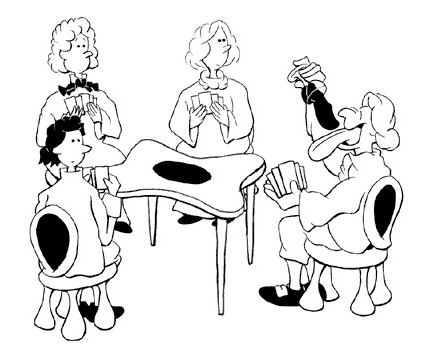 Not that they would confuse the two. After all, George Washington powdered his hair and pulled it back in a bun. Also when George was Boris's age, he would crack nuts with his ever decreasing number of teeth. Certainly the King does none of these - or at least we don't think he does.
Not that they would confuse the two. After all, George Washington powdered his hair and pulled it back in a bun. Also when George was Boris's age, he would crack nuts with his ever decreasing number of teeth. Certainly the King does none of these - or at least we don't think he does.
Although as a young man George had achieved some fame when he single-handedly started the French and Indian War by opening fire on a French diplomatic entourage, his true international celebrity began when the Continental Congress voted him the Commander-in-Chief of the American Army. In his patriotism, we hear, George refused to accept a salary, but only asked for reimbursements for - quote - "necessary expenses" - unquote. Of course, his "necessary expenses" included things like $7644 for five horses and a carriage to take him from Philadelphia to Boston (the carriage cost $1430, the horses averaged $1433 each), a harness for $201, $65 for cleaning of his headquarters, and $58 for a French cook. And in seven months - from September 1774 to March 1775 - he spent over $6000 on wine and other beverages.
So not only did George like to ride in style, hated dirt, and enjoyed French cuisine, he obviously took the occasional toddy. But of course George did not drink the $6000 worth of booze himself. Since fellow officers, Congressmen, and diplomats all came to visit the new commander-in-chief, we can bet they drank their fair share. The onslaught of visitors never stopped and after the war, George had to keep a particularly well-stocked cellar since he and Martha ended up having to entertain up to 600 guests a year at their Mount Vernon estate.
In George's day, wine connoisseurs tended to sport a sweeter tooth than we have today and preferred varieties like port and Madeira (one of George's favorites). But according to Mount Vernon's visitors, there were times George forsook such aristocratic beverages. He, in common with most colonists, also drank beer and ale. In fact, beer was a staple beverage and was drunk at most meals. When John Adams was in Philadelphia as a member of the Continental Congress he began each day with a mug of the justly celebrated Philadelphia brew. Given the volume of consumption, beer was bought by the barrel, cask, or keg. Or you could, as did George, make it yourself.
Now back in George's day beer wasn't necessarily the same as we have today. There was a decided preference for drinks flavored with weird - sorry, that's "exotic" - additives. In good old colony times you had birch beer, spruce beer, pumpkin beer, cinnamon beer, and (bleah) parsnip beer. In fact, the ingredients were so varied that some beers were not really beer. Particularly the beer George made for the kids.
Yes, the kids. George Washington made beer for his step-kids. But before you go off into spittle flinging diatribes about this being trash-the-great-man revisionist history, we caution that we are referring to "small" beer. Small beer, in fact, was consumed by everyone with few side effects since it was low in alcohol. A chemist of the Royal Society had analyzed the alcohol contents of various small beers and found they were between 1 and 2 % alcohol by volume (%ABV) - not as low as modern "non-alcoholic beers" (which have to be less than 0.5 %ABV), but still much lower than our own typical beers and ales (which are 5 - 6 %ABV).
Contributing to the popularity of small beer was its safety. Although no one knew the actual reasons (they didn't know about germs), people had learned that if your drinks were made from boiled water, then you didn't get sick or die as often as if you drank water from the rivers, streams, or wells (actually most people who died did not die often, only once). So George wrote up a recipe for small beer which as we said was not a beer.
But why, you ask, was George's Beer-For-The-Kids not a beer? Or rather let's ask the general question. Just what makes a beer a beer?
Now we could take the tack of Humpty Dumpty and say a word means what we want it to mean, nothing more and nothing less. Then we can say the Vikings drank mead, which is a beer made from honey, and the Japanese drink sake, a wine made from rice. And if we want, we can say Herodotus was perfectly correct to say that the ancient Egyptians drank a wine that they made from barley.
So why, then, do people say wine is made from grapes and beer from grain? And just what do we call drinks made from honey, dandelions, or honeysuckle petals? Are you making a wine or a beer?
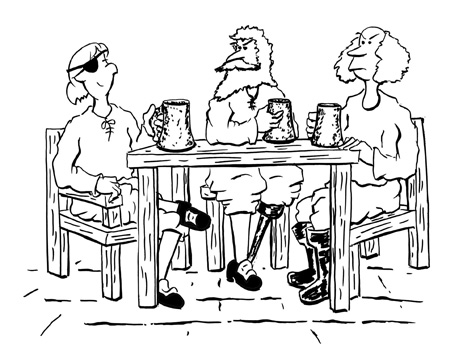
It turns out that the best way to classify beverages is from the actual process and chemistry of their making. So to distinguish a wine from a beer we focus on the ultimate source of the alcohol. Now everyone knows that alcohol - specifically ethyl alcohol - is formed from sugar when you mix it with yeast. But one thing to remember when making booze is you don't need to start with sugar at all. And this is the key to telling a beer from a wine.
So rather than say a wine is made by using these-or-those ingredients and beer from those-and-these ingredients, we will define wines and beers based upon the sugar content in the original mix. A wine, we will say, is a non-distilled fermented drink which is made from any ingredients with a high natural sugar content. For a beer your starting ingredients have little or no initial sugar but instead the sugar forms during the brewing process.
To make a wine, then, you simply take something with a lot of sugar - grapes, for instance. Mash them up so you get the juice. Toss in the yeast, let it sit and hey, presto!, you have your wine.
But for beer you don't start off with stuff with sugar. Instead, you make it as you go along. The simplest way to do this is to, yes, start with grain. But first we have to "malt" the grain. This will produce (what else?) malted grain or just malt. Other ingredients - flavorings like hops, sassafras roots, birch bark, and parsnips - don't really appear in the definition of beer.
To make malted grain you soak it in water and then spread it out on the floor. After it begins to sprout (called germination) you then take the grain, dry it out, and (optionally) roast it. Now malting doesn't necessarily make the sugar but it does generate the enzymes that break down the starch in the grain. That makes the sugar.
If all the grain used to make beer had to be malted, beer would cost more than what we're used to paying. But since the malted grain is used as the source of the enzymes - which as everyone knows are natural catalysts - you first boil up some non-malted grain. Then when that's nice and cooked you mix in some malt. The enzymes then begin to react with the starches, and then you get the sugars that make the alcohol.
Notice that although a drink made from grain is a beer by our definition, the grain per se doesn't enter into the definition. For instance, if you took potatoes - high in starch, low in sugar - in place of grain, you would also be making a beer. Nor does the final drink's appearance, color, or if it has the carbonation that produces a nice foamy top matter. For instance, Japanese sake is clear and non-carbonated. But it is made from rice - low in sugar - and so is a beer, not a wine. And the Vikings' mead - a golden beverage which often has a nice foamy top - is made from honey. But since honey is high in naturally occurring sugar, mead is actually a wine.
And George's "small" beer? Well, the recipe he gave us was pretty simple. He would first boil up some bran and hops and filter off the water which he would then add to a tub of water. To this he would add molasses and let it sit for a day. Then he'd pour it into a cask, add yeast, and let it ferment, being careful not to close up the cask completely until the fermentation was "almost done working". You bottle it the day or week it was done (sometimes George's instructions were a bit ambiguous).
Now the big question. Is this, George's "small beer", a beer?
Well, you say, George did used bran (a grain). So it looks like he made a beer.
Weeeeeeellllllll, not quite. Note that George doesn't mention "malting" the bran. Instead, the bran is what - along with the hops - adds flavor to the drink. But most of all, note that George adds molasses. And molasses, as everyone knows, is a syrup made from sugar bearing plants like sugar cane and sugar beets. So George's small beer recipe starts off with ingredients with a high natural sugar content.
Yes, George's "small beer" was really a wine.
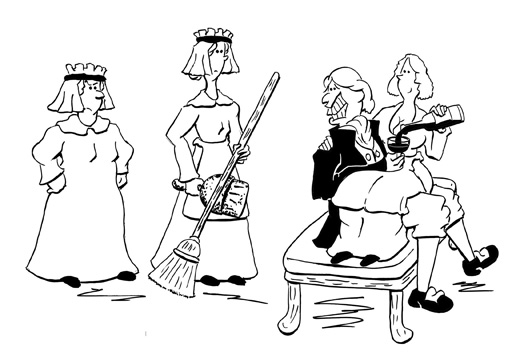
Some people may not be convinced with the previous argument. After all, the way George made his small beer was a lot like making beer from a kit (advisable for the first time home brewer). If you buy a beer-making kit which comes with the ingredients, you will probably get a can of malt "extract". That is, someone else has taken the grain, malted it, and made the sugar already. So all you have to do is dump this syrup in the water and then toss in the yeast. That's pretty much what George's recipe was like although he used the molasses instead of the malt extract.
What then was the difference? Are you really making a wine if you make beer from a kit?
Nope, you're making a beer. That's because the malt extract's original source was grain, and the extract is an intermediate of the process. The overall process started with grain which is low in sugar. You made a beer.
Today "authentic" recipes of the colonial beers are often altered and carbonated to suit modern palates. But in George's time there was no way to artificially boost the carbonation, and so George's beers would taste flat to the modern connoisseur. That would be particularly the case of beer kept in wooden casks. In fact, even as late early 20th century home brew manuals (particularly from England) define "draught" as the same thing as flat beer.
Some of the more adventurous modern home brewers have indeed made George's small beer. Their consensus, we should say, doesn't bode well for those who want to toast the memory of America's First Founding Father with his own beverage. Reportedly it had a syrupy and bitter taste. So it's not likely that George told his step-kids and grandkids that they wouldn't get any dessert unless they drank their beer.
Sadly, this is the only recipe we have from George's own hand. But we know he made other types of beer and some were full strength, around 5 - 6 %ABV. Supposedly George's beer was among the best in the nation.
But before we go further, let's anticipate an objection. Of course, George didn't make the beer himself. Instead, it was the workers on the farm under the supervision of his managers that did it. And yes, many of the workers were slaves. But some were also hired free men. George, we should point out, was very democratic in his hiring and didn't care tuppence about a workers personal beliefs or ethnicity, only their ability. "If they are good workmen," he wrote to Tench Tilghman, a friend from the Continental Army, "they may be of Asia, Africa, or Europe. They may be Mahometans [sometimes George didn't spell so good], Jews, or Christian of any sect, or they may be atheists." So George was not only first in war, first in peace, and first in making booze, but also the first equal opportunity employer. And it was a Scotsman - James Anderson - that George hired as the last manager of Mount Vernon. James had also been a distiller, and he was the perfect choice for Mount Vernon's last venture - making whiskey.
Why whiskey? Well, in his later years George found the farm wasn't making the money it used to. Oh, he wasn't in the same situation as Thomas Jefferson who actually went broke after he left the White House. But George decided to - as we say today - consolidate his business to core areas. And making whiskey was about as core as he could get.
Despite historians painting George as a inept general who lost more battles than he won (which is true) and whom his own subordinates tried to get rid of (which is also true) - he was a capable manager who could analyze situations and decide what was wrong and what needed fixing. For instance almost as soon as he inherited Mount Vernon (from his brother) and married Martha (and with it Martha's considerable wealth), he had recognized that tobacco was not a good crop. It took a lot of manpower (and womenpower) and it depleted the soil. Worse, most was sold through brokers in England who George thought was ripping him off.
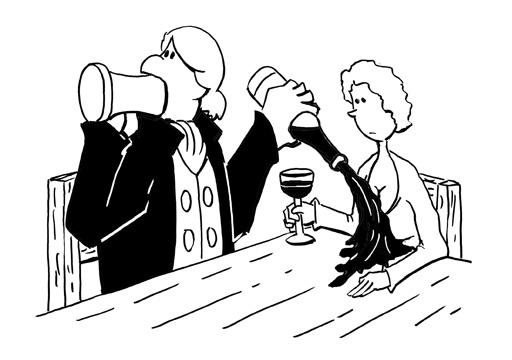
So early on George decided to try growing wheat. But transportation costs of wheat are pretty high - it has a fairly low density (weight per volume) - and it takes up a lot of space. It is also a commodity product where profits tend to be low.
Now every businessman knows that if you want higher profits one thing to do is to branch into lower volume but higher priced "specialty" products. So if George could come up with the right specialty he could make the same or higher gross income than his wheat. Although he would sell fewer pounds, he has lower shipping and handling costs, and the overall profits would be higher. So more money would go into his pocket.
The first thing George tried was to put up a grist mill to make flour. This worked OK, and George sometimes paid for his Portuguese Madeira with Mount Vernon flour. But flour is still pretty bulky and is not really a specialty. Whiskey, though, takes up less space than flour with about 7 gallons of wheat making about 4.5 gallons of whiskey. Of course, George couldn't put all of his grain into whiskey, but even converting a part of the crop would increase Mount Vernon's profitability. So George made whiskey.
Just as beer and wines have their definitions distilled spirits have theirs. But here we do have to stick with definitions based on actual materials rather than chemistry - although the process is sometimes part of the definition as well. Some definitions are simple, some are complex. For instance, brandy comes from distilling wine - a simple definition. But vodka can come from anything with alcohol, but with the distillation carefully controlled so that for all practical purposes you get just alcohol and water. Whiskey, on the other hand, is defined as a distilled beverage where the alcohol comes from grain. So this sounds like you can take beer, distill it and you have your whiskey. This is true enough and is sort of what George did.
But not exactly. We mentioned that American beers usually have 5 - 6 %ABV. This is low compared to wines (typically 12 - 20 %ABV). Rather than just distilling beer taken from the cask, a more economical process would be to start off with a beer with more alcohol. For instance if you had 20 % alcohol, you would produce four times the whiskey than if you had just distilled a 5 % beer. So with the same manpower and time, you quadruple your income.
The oldest distilled whiskey is probably Chinese baiju. This is made by distilling huangjiu, which is made from rice and so is the Chinese analog of Japanese sake. Huangjiu is indeed about 20 % alcohol. So you could just take huangjiu, distill it, and you'd get a drink well worth the money.
But in western cultures, whiskey makers do not intentionally distill the beer that was intended for drinking. Instead they start off by making a specific whiskey mash. Mash, as the name implies, is prepared by mashing the grain in water. When it's first prepared, the mash is thick, almost a mush (in fact, the words "mash" and "mush" are etymologically related). Mash is also what you make when brewing beer, but whiskey mash has more grain and so produces more alcohol.
Again in keeping with good business practice George's built his distillery next to - that is, "downstream integrated" - to his grist mill. "Grist" is ground up grain, but not so fine as to be called flour. The grist George used in his whiskey was usually rye wheat and corn (maize if you're not from the US). The mash was boiled up, and the boiling extracts the starches from the grain into the water. The mixture gets even thicker since the starches and water form gels just like when you add starch to make other foods thicker.
At this point distillation would not only be pointless (there's no alcohol yet), but difficult - it's not easy to distill sludge. But George would then add in malted barley. You'll remember that malt breaks down starches and so after he added the malt, the starchy gels would disperse and you end up with a nice flowable liquid. You then add your yeast and let the mixture ferment.
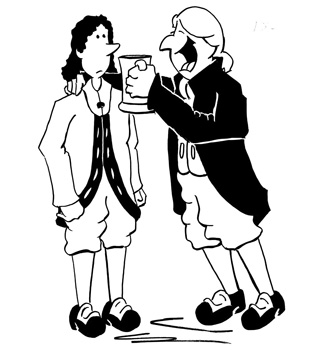
Fermentation does two things. First, of course, it makes the alcohol. Next it reduces the density of the liquid (alcohol is less dense than water) and this helps the solids settle out. So when you pour off the liquid - now a high alcohol beer - into the still, you don't have many solids which might cause the liquid to bump when distilling.
Large commercial distilleries don't do the mashing, mixing, and fermenting all in one pot like George did. Also their stills are what we call "continuous". That is you pump in the liquid at the same time the whiskey distills off and as the residue is removed. So a continuous distillation lets you maintain a constant liquid level in the still. A continuous still makes it easier to keep a steady output at a given alcohol content.
But George's stills were the more traditional "batch" stills. They were copper pots with removable heads with the attached spout (the head where the vapors rise was called the "onion"). The spout was cooled simply by running mill water over it. The vapors then condense and the liquid - essentially a water/alcohol mixture - would be collected in wooden casks. That was George's whiskey and it was then shipped out.
Today whiskey is aged in charred wooden barrels. In fact, to call your grain-distilled drink a "whiskey" at some point it must come into contact with a wooden cask. But that rule was implemented long after George's time, and besides his whiskey was put into wooden casks, anyway. But George's whiskey was not aged. It went directly from Mount Vernon to nearby towns like Alexandria where it was sold to the thirsty.
Without the aging, George's whiskey was not the amber colored and relatively mellow beverage we know. Instead it was water white and yet it has - according to those who have sampled later day runs - a surprisingly good taste.
George's whiskey business started relatively late in 1797. His first year realized only about 600 gallons. But the next year he made 4500 gallons, and finally reached 10,500 gallons in 1799. This was extremely large scale production for the time, and George was indeed first in making whiskey. Sadly, George didn't get to see next year's production since he died on December 14, 1799.
So how much did George make from his distillery? Well, according to the records, taxes ate up a lot of his profit the first year. He paid about $330 tax on his 600 gallons - more than 50¢ per gallon. So at $1 a gallon - George's price for his best stuff - his tax rate was about 50 %. But we guess George had chosen the "flat-tax" option available for whiskey producers. By 1799, when he made his 10,500 gallons, he realized a profit of $7500.
Well, you say, that was pretty good money. After all, that was in 1799. So that must be a lot of money today. Well, it certainly is more. If you go by the CPI (that is, the consumer price index) from 1799 to today, George's profits would be more like $150,000. And this was just one of Mount Vernon's products. Yes, George was doing all right in his later years.
It turns out that what George charged even for his top-drawer stuff was pretty reasonable if you plot $1 per gallon from 1799 on the Consumer Price Index (CPI) to what it is today. As you can see in the graph (use the "View Figure" option in the browser to expand the image), George's whiskey was selling for $25 a gallon in today's money.
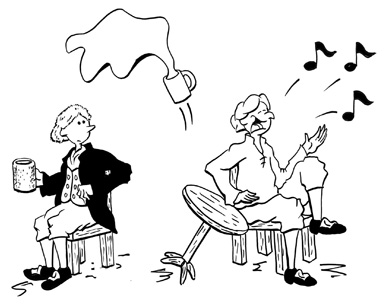
A warning, though, to those who want to emulate the Father of His Country's Beverage Business. Since 1978 the federal law has permitted individuals to make limited amounts of beer for their personal use (home wine making was always permitted). So you can make George's small beer if you wish. However, that is not the case for distilled spirits. Anyone who even sets up a still for distilling potable alcohol is required to register the still with the federal government and obtain a permit. But good luck if you try since the federal government is reluctant to issue the licenses to anyone but commercial distilleries - not home do-it-yourselfers. Of course - as befits a time when states are wanting to secede from the Union - some legislatures have passed laws thumbing their nose at the federal law and permit "personal use" exemptions. But strictly speaking the Federal laws trump the state although you wouldn't know it given recent events.
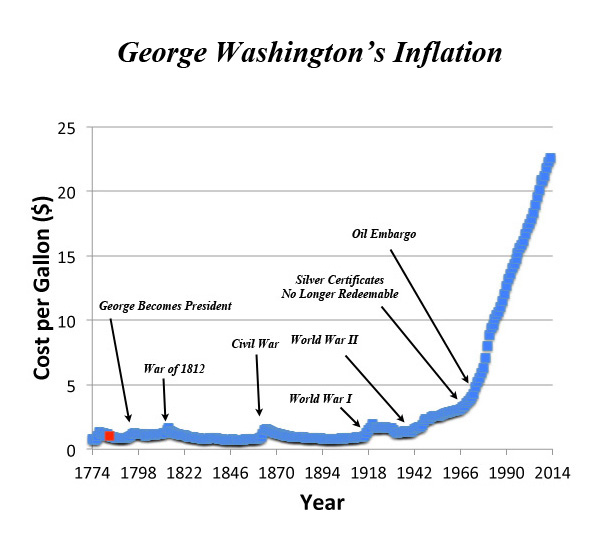
For what it's worth, George did submit his expense account to Congress after the American Revolution. Now you will read that George ripped off the government by submitting such extravagances as we cited above. He asked for (and got back) nearly $450,000 and we learn that the expenses of His Exorbitancey was the reason Congress decided to offer him a yearly salary of $25,000 when George was elected president. So in his eight years as chief executive George received a measly $200,000 - but at least this was in a day when there was no income tax.
Others, though, say George only got $160,000 for his "necessary expenses". But whatever the sum, we need to remember that George's expenses as Commander-in-Chief included not just his personal costs but also what it cost to keep his headquarters - and sometimes the entire army - going. All in all, George's personal "necessary expenses" were more that a typical general's salary, but not out of line with his presidential compensation. So it looks like George wasn't ripping off the government as much as some of the Internet articles would like you to think.
References
Founding Spirits: George Washington and the Beginnings of the American Whiskey Industry, Dennis Pogue, Harbour Books, 2011
"What Did George Washington Drink?", William Bostwick, the New York Times, November 19, 2011
"To Make Small Beer", George Washington, 1757 Notebook, New York Public Library, http://www.nypl.org/locations/tid/36/node/40921
"Colonial Ale", Dan Mouer, Brew Magazine, Jan/Feb 2003
"Beer", A Dictionary of Science, Literature, and Art: Comprising the Definitions and Derivations of the Scientific Terms in General Use, Together with the History and Descriptions of the Scientific Principles of Nearly Every Branch of Human Knowledge, William Thomas Brande, D. C. L., F. R. S. L. & E, and Rev. George W. Cox, M. A., Harper Brothers, 1851.
The Alcoholic Republic: An American Tradition, William Rorabaugh, Oxford University Press, 1979
George Washington's Mount Vernon, http://www.mountvernon.org/. Information on George and his famous farm. Specific articles include:
- "Distillery", George Washington's Mount Vernon, http://www.mountvernon.org/distillery. Mount Vernon's distillery makes limited runs of George's whiskey. It costs, to say the least, a bit more than what George charged, even correcting for inflation.
- "Whiskey Production", George Washington Digital Encyclopedia, Emma Bilski, http://www.mountvernon.org/educational-resources/encyclopedia/whiskey
- "Beer", George Washington Digital Encyclopedia, Mary V. Thompson, http://www.mountvernon.org/educational-resources/encyclopedia/all-entries-subject/social-life/beer
"George Washington's New Whiskey: Founding Father Of American Distilling Is Back!", Larry Olmsted, Forbes Magazine, 4/04/2012, http://www.forbes.com/sites/larryolmsted/2012/04/04/george-washingtons-new-whiskey-founding-father-of-american-distilling-is-back//p>
"Drinking George Washington's Beer", Lea Koenig, Saveur, http://www.saveur.com/article/Wine-and-Drink/George-Washington-Beer
"Bottle Typing/Diagnostic Shapes: Beer & Ale Bottles", Society of Historical Archeology, http://www.sha.org/bottle/beer.htm
"Kitchen Anthropology: Home Brewing an Ancient Beer", Ed Hitchcock, Brewing Techniques September/October, 1994
"Financial Paper: 1750-1796", George Washington Papers, Library of Congress, http://memory.loc.gov/ammem/gwhtml/gwseries5.html
George Washington's Accounts of Expenses While Commander-In-Chief of the Continental Army 1775-1783 Reproduced In Facsimile with Annotations, George Washington, John Fitzpatrick (Editor), Houghton Mifflin, 1917
George Washington's Expense Account, Marvin Kitman, Simon & Schuster, 1970
Currency Converter, "Pounds Sterling to Dollars: Historical Conversion of Currency", Eric Nye, Department of English, University of Wyoming, http://www.uwyo.edu/numimage/currency.htm. Exchange rates from 1264.
Return to Merry History Table of Contents
Return to CooperToons Home Page